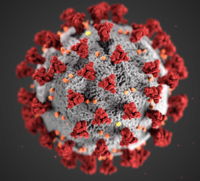Coronavirus Disease 2019 (COVID-19)
From Proteopedia
(Difference between revisions)
| Line 1: | Line 1: | ||
<StructureSection load='6vsb' size='250' side='right' scene='83/839266/Covid-19_spike/6' caption='COVID-19 surface spike (PDB entry [[6vsb]])'> | <StructureSection load='6vsb' size='250' side='right' scene='83/839266/Covid-19_spike/6' caption='COVID-19 surface spike (PDB entry [[6vsb]])'> | ||
| - | [[Image:COVID-19.jpeg|left| | + | [[Image:COVID-19.jpeg|left|200px|thumb|COVID-19 (CDC/Eckert & Higgins)]] |
A novel coronavirus was identified as the cause of an outbreak of respiratory illness first detected in Wuhan, China in 2019. The illness caused by this virus has been named coronavirus disease 2019 (COVID-19). The illustration (left) shows the overall structure of the COVID-19 virus. Note the spikes that adorn the outer surface, colored <span style="color:red">red</span>, which impart the look of a '''corona''' surrounding the virus. A close up view of these spikes can be seen on the right, from studies by McLellan lab<ref name="McLellan">PMID:32075877</ref>. An animation (by [http://elarasystems.com Elara Systems)] shows how [http://www.dropbox.com/s/24e5f5wdh64f5fv/ES_NL_CoronaVirus_Final.mp4?dl=0 COVID-19 interacts with its host], via these spikes, thus permitting its genome to enter the host (human) cell<ref name="McLellan" />. | A novel coronavirus was identified as the cause of an outbreak of respiratory illness first detected in Wuhan, China in 2019. The illness caused by this virus has been named coronavirus disease 2019 (COVID-19). The illustration (left) shows the overall structure of the COVID-19 virus. Note the spikes that adorn the outer surface, colored <span style="color:red">red</span>, which impart the look of a '''corona''' surrounding the virus. A close up view of these spikes can be seen on the right, from studies by McLellan lab<ref name="McLellan">PMID:32075877</ref>. An animation (by [http://elarasystems.com Elara Systems)] shows how [http://www.dropbox.com/s/24e5f5wdh64f5fv/ES_NL_CoronaVirus_Final.mp4?dl=0 COVID-19 interacts with its host], via these spikes, thus permitting its genome to enter the host (human) cell<ref name="McLellan" />. | ||
<br> | <br> | ||
Revision as of 10:15, 23 March 2020
| |||||||||||
References
- ↑ 1.0 1.1 1.2 Wrapp D, Wang N, Corbett KS, Goldsmith JA, Hsieh CL, Abiona O, Graham BS, McLellan JS. Cryo-EM structure of the 2019-nCoV spike in the prefusion conformation. Science. 2020 Feb 19. pii: science.abb2507. doi: 10.1126/science.abb2507. PMID:32075877 doi:http://dx.doi.org/10.1126/science.abb2507
- ↑ Gordon, et al. A SARS-CoV-2-Human Protein-Protein Interaction Map Reveals Drug Targets and Potential Drug-Repurposing: bioRxiv (online) 2020[1]
- ↑ Gautret, et al. Hydroxychloroquine and azithromycin as a treatment of COVID-19: results of an open- label non-randomized clinical trial: Intl J Antimcrob Agents (in press) 2020 [2]
- ↑ Gao, et al. Structure of RNA-dependent RNA polymerase from 2019-nCoV, a major antiviral drug target: bioRxiv (online) 2020[3]
- ↑ Jin, et al. Structure of Mpro from COVID-19 virus and discovery of its inhibitors: bioRxiv (online) 2020[4]
- ↑ Andersen, et al. The proximal origin of SARS-CoV-2: Nature Med (in press) 2020[5]
- ↑ Yan R, Zhang Y, Li Y, Xia L, Guo Y, Zhou Q. Structural basis for the recognition of the SARS-CoV-2 by full-length human ACE2. Science. 2020 Mar 4. pii: science.abb2762. doi: 10.1126/science.abb2762. PMID:32132184 doi:http://dx.doi.org/10.1126/science.abb2762
- ↑ Dong L, Hu S, Gao J. Discovering drugs to treat coronavirus disease 2019 (COVID-19). Drug Discov Ther. 2020;14(1):58-60. doi: 10.5582/ddt.2020.01012. PMID:32147628 doi:http://dx.doi.org/10.5582/ddt.2020.01012
Proteopedia Page Contributors and Editors (what is this?)
Joel L. Sussman, Jaime Prilusky, Eric Martz, Jurgen Bosch, David Sehnal, Gianluca Santoni

